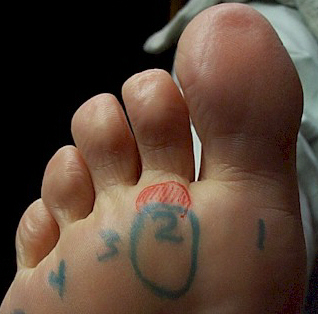
Capsulitis
Synopsis
Capsulitis is an inflammatory condition that can occur at any joint, but most frequently effects the foot beneath the forefoot. Inflammation of the joint capsule of the forefoot can be caused by systemic diseases but is most often caused by excessive mechanical load being applied to the forefoot. The most common site that capsulitis occurs is beneath the second metatarsal head. The symptoms of capsulitis are particularly noticeable when patients are barefoot on hard surfaces such as hardwood, tile or concrete floors. Pain increases with the time spend on hard surfaces and seems to decrease with padding.

Typical Location for a capsulitis shown in red, while on the second head it can occur on others as well or multiple heads simultaneously
Anatomy and Development
Capsulitis most commonly occurs at the metatarsal phalangeal joint of the forefoot. This joint consists of the head of the metatarsal, which is covered in cartilage, and the base of the proximal phalanx, or bone of the toe. Numerous tendons traverse the joint and pull like the reins of a horse to guide the motion of the toe. Blood vessels and nerves also pass the joint as they travel to the end of the toe.
The development of capsulitis is very dependant upon the length of each metatarsal bone. The longer the metatarsal bone, the greater the tendency for capsulitis to occur. Let's use a silly example to describe why; take two bamboo poles, one five foot long and another ten feet long. Hook them under your arms and hold them out in front of you , parallel to the ground. Now slowly lower the poles. The longer of the two poles, the ten foot pole is going to hit the ground first, followed by the shorter five foot pole. This is essentially how the long metatarsal bones of the forefoot carry our body weight. With each and every step, this load reoccurs. Ideally, we'd like to see that load applied to the foot is applied in such a way that it is equally distributed. Equal distribution of load helps to prevent focal loading on any one bone or soft tissue structure. But often we'll see that the bone behind the second toe, called the second metatarsal, is long, just like the ten foot bamboo pole. Repetitive loading of the second metatarsal results in inflammation of the tissue structures beneath the metatarsal head (ball of the foot) and capsulitis begins.
Diagnosis and Treatment
The first step in treating forefoot capsulitis is to find ways to off load the forefoot. Off loading is a simple technique that can be achieved in many different ways. Pads and cushions are by for the most popular ways to off load the forefoot. Metatarsal pads are also a common shoe modification used to off load. A trip to any pedorthic shop will be a valuable lesson for anyone with forefoot capsulitis. The pedorthic shop can explain the size, placement and logic behind the use of a metatarsal pad. Shoes can also be used to off load the forefoot. A simple example are clogs. The rocker sole on clogs has been used for years to off load the forefoot. Orthotics are another method of off loading. Many times accommodations are made on the orthotic specifically for this purpose.
Surgical procedures may help. In particular, a metatarsal osteotomy can be used. An osteotomy is a surgical fracture in the metatarsal bone to raise the metatarsal head up and away from the ground.